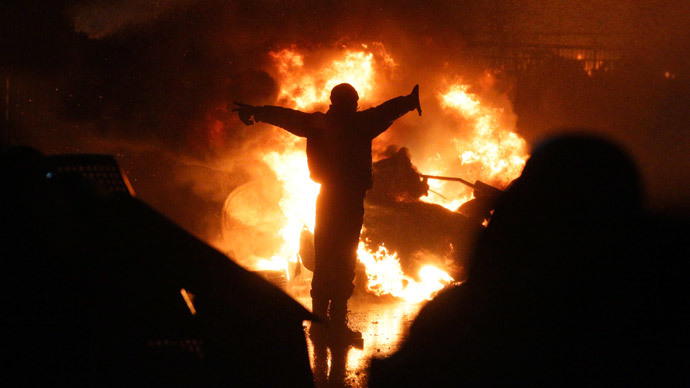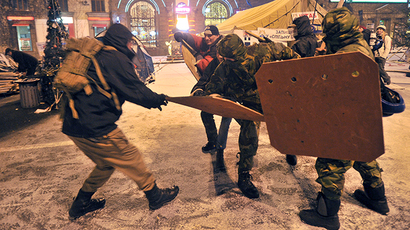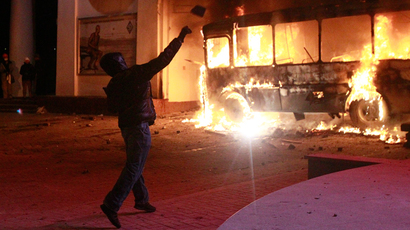#EuroMaidan revolution: 2014 Ukrainian coup timeline

One year after the violent coup in Ukraine, RT recreates the four days of bloody clashes of February 2014, which saw approximately one hundred people killed in central Kiev and resulted in a power shift in Ukraine.
The Euromaidan rallies began in central Kiev in November 2013 after then-Ukrainian president, Viktor Yanukovich, postponed the signing of an association agreement with the European Union. The protests came to a head in February the following year as violent clashes between the rioters and police triggered a dramatic change in Ukraine’s history.
Tuesday, February 18
Around 20,000 protesters marched toward the national parliament, the Verkhovna Rada, in what has been dubbed a “peace offensive,” but it soon degenerated into a violent standoff with the police.
Battlefield Kiev: Molotov cocktails reign down, rioters rough up police (VIDEO)
Many of those who clashed with law enforcers looked more like well-trained extremists rather than ordinary demonstrators. Wearing black masks, helmets, some also equipped with bulletproof vests, they pelted riot police with rocks and Molotov cocktails, as well as shooting fireworks.

The authorities responded with water cannon and tear gas. Live rounds were reportedly fired by both sides. Violence continued overnight and by morning, at least two dozen people were killed, including up to ten policemen. Hundreds more received injuries.
Talks between Ukrainian govt, opposition fail as Kiev gripped by unrest
As protests intensified, the opposition demanded a return to the 2004 constitution, which would make Ukraine a parliamentary, rather than a presidential, republic. The ruling party at the time insisted that the opposition’s demands intrinsically violated the Ukrainian constitution.
That day, Crimean authorities warned that the general mobilization called for by far-right groups was a definite attempt to start a civil war in Ukraine and “a new attempt at a forceful power grab.” The peninsula’s authorities urged Yanukovich to come up with “decisive action and emergency measures” to end riots and restore constitutional order.
PHOTOS, VIDEO: Fresh riots in Kiev, violent clashes, tires burn downtown
Wednesday, February 19
Tensions were high following the deadly events of Tuesday. A huge fire began at the House of Labor Unions, cloaking Maidan (Kiev’s Independence Square) with thick black smoke.
Police checkpoints were set up across Kiev, schools were closed and restrictions on public transport were introduced in a de facto state of emergency.
As the situation intensified, US President Barack Obama said that the US “condemns in the strongest terms the violence” in Ukraine, adding that the Ukrainian government must uphold the rights of peaceful protesters and refrain from using force.
Away from the capital, rioters looted a depot in western Ukraine, making off with more than a thousand guns. Rioters attacked police and government offices, setting buildings on fire, scattering documents and smashing furniture.

However, a shaky truce was agreed in Kiev between President Yanukovich and the leaders of three top opposition parties – the nationalist Svoboda opposition party, Oleg Tyagnibok, Batkivshchyna opposition leader Arseniy Yatsenyuk, and Ukrainian Democratic Alliance for Reform (UDAR) party leader Vitaly Klitschko.
Yet the far-right wing of the Ukrainian opposition refused to observe the truce. The leader of Right Sector (Pravy Sektor) said that the group did not sign any agreements and called for the continuation of the “offensive of the resurgent people.”
Thursday, February 20
The next day of the protest, now known as Bloody Thursday, became the most violent day in Kiev since the World War II.
Rioters ignored the truce and started an early morning revolt against the authorities. Gunfire broke out again on the square, hitting both protesters and police. Many of the victims were shot by snipers from nearby buildings. It’s still not clear, who the shooters were and whose orders they were executing, with both sides still blaming one another.

In the chaos, the rioters managed to push the law enforcers off the Independence Square and back into nearby streets, capturing dozens of police officers. With exact figure still unknown, it’s believed that nearly 100 people could have lost their lives that day alone.
As events got worse, and the demands for ultra-nationalists and radicals to lay down their arms and “return to peaceful protesting” failed, the Interior Ministry officially authorized the use of weapons by law enforcers to “protect citizens, rescue hostages, and counter life-threatening attacks.”
Events became so intense that EU Foreign Ministers from Poland, France and Germany, who were scheduled to meet Yanukovich and the opposition to broker a peace deal, had to leave the Ukrainian capital because of security concerns.
Friday, February 21
After what they themselves called “a night of difficult negotiations” the European foreign ministers brokered a new peace deal. The breakthrough agreement was witnessed by Poland’s Radoslaw Sikorski, France’s Laurent Fabius and Germany’s Frank-Walter Steinmeier.

Yanukovich gave in to the demonstrators’ demands and announced early presidential elections and the return to the constitution of 2004 – with a new coalition government to be formed within 10 days. He also announced a third round of amnesty for all involved in violent rioting and agreed to refrain from imposing a state of emergency, giving protesters up to three days to surrender all illegal weapons.
The Ukrainian parliament in the meantime, banned the use of firearms by law enforcers and voted to pull back troops from Kiev, with over 80 percent of the ruling party’s MPs not showing up for the vote. At the same time a presidential impeachment bill was introduced in the parliament.
During the day police and other security forces began moving out of the capital. By the evening however radical rioters announced that truce or no truce, they were still willing to use force to make the president step down immediately.
The following night Yanukovich fled the capital in fear of his life and shortly after he was ousted from power.
Watch RT’s documentary ‘Divided nation: Views from both sides of the Kiev barricades’ for more insight on the tragic events in the Ukrainian capital last year.














